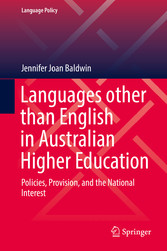Suchen und Finden
Service

Languages other than English in Australian Higher Education - Policies, Provision, and the National Interest
Jennifer Joan Baldwin
Verlag Springer-Verlag, 2019
ISBN 9783030057954 , 262 Seiten
Format PDF, OL
Kopierschutz Wasserzeichen
Geräte
Mehr zum Inhalt

Languages other than English in Australian Higher Education - Policies, Provision, and the National Interest
Dedication
6
Contents
7
Abbreviations
10
List of Tables
12
Chapter 1: Introduction
13
1.1 Australia: The British Colony
13
1.2 Research Questions
15
1.3 Themes
17
1.4 Discussion of Literature and Other Sources
20
1.5 Overview of the Book
25
1.6 Conclusion
27
Chapter 2: The Founding of Australian Universities
29
2.1 The Foundation of Universities in the Colonies
30
2.2 Two British Colonies: Canada and New Zealand
32
2.3 A Second University in Melbourne, Australia
33
2.4 A Third Colonial University in Adelaide
35
2.5 The Later Colonial Universities
36
2.6 The Language Offerings of the Universities
38
2.7 The Importance of the Classical Languages
38
2.8 Modern European Languages
41
2.9 The Melbourne Solution for More Languages
48
2.10 Asian Languages
50
2.11 Conclusion
54
Chapter 3: Post-War Expansion
56
3.1 Post-World War II Australia
58
3.2 The Mills Report: The First Reckoning
61
3.3 Murray Report and More Commonwealth Control
63
3.4 Martin Report: A New Framework for Higher Education
66
3.5 The First Survey of Language Teaching
70
3.6 Auchmuty Report: The First Asian Languages Report
71
3.7 Concurrent Language Surveys: Kramer and the Academy of the Humanities
72
3.8 The Galbally Report: Migrant Services and Programs
76
3.9 National Policy on Languages
79
3.10 The Dawkins Era: Reforms and More Reports
80
3.11 Conclusion
84
Chapter 4: Australia: Both Multicultural and Multilingual
86
4.1 Migration to Australia
87
4.2 Academic Interest in Migrant Languages
91
4.3 Assimilation to Integration
93
4.4 The End of the White Australia Policy and the White Zealand Policy
96
4.5 Kramer Report: A Timely Report into Languages
99
4.6 A New Government in a New Era
101
4.7 Galbally Report: A Report for Migrant Services
102
4.8 The Consequences for Community Languages
106
4.9 The Fortunes of Ukrainian and Yiddish: Case Studies
109
4.10 Conclusion
113
Chapter 5: Three Trade Languages: Japanese, Chinese and Indonesian
115
5.1 Australia/Japan Contact Begins with Trade
116
5.2 Japanese Language
117
5.3 Defence Needs Japanese Skills
120
5.4 From Defence Needs to Trade Needs
121
5.5 The Influence of Universities on Japanese in Schools
123
5.6 Chinese Migration to Australia
125
5.7 Trade and Diplomacy with China
127
5.8 The Imperative for Chinese Language Teaching
128
5.9 Oriental and Asian Studies Expand
130
5.10 Official Recognition of China
133
5.11 Indonesia: Trade First Then Security and Defence
135
5.12 Government Commitment to Indonesian Language Teaching
137
5.13 Auchmuty and Kramer Reports: Stocktakes for All Languages
139
5.14 The Testing of Diplomatic Relations and Language Popularity
140
5.15 Conclusion
144
Chapter 6: Three Strategic Languages: Russian, Korean and Arabic
146
6.1 Early Australian Relationships with Russia
148
6.2 Russian Language Begins at University of Melbourne
150
6.3 Collapse of Soviet Union
155
6.4 Australia’s Relationship with Korea
157
6.5 Arabic: A Pluricentric and Religious Language
161
6.6 Arabic as a Scholarly Language
161
6.7 Arabic as a Migrant Language
163
6.8 Arabic as a Trade Language
166
6.9 Waning Support for Arabic in the Universities
167
6.10 Conclusion
168
Chapter 7: Languages in the 1990s: The Context and the Changes
169
7.1 Comparison of University Languages Structures
170
7.2 A Case Study of the University of Melbourne
172
7.3 A Review of Languages
178
7.4 The New School of Languages at the University of Melbourne
181
7.5 Other Universities’ Languages Structures in 1999
183
7.6 Political Implications for Languages
186
7.7 Reports from the Academic Sector
187
7.8 Conclusion
190
Chapter 8: The Asian or Global Century?
191
8.1 Government Languages Policy from Mid 1990s to Early 2000s
192
8.2 Internationalisation
195
8.3 Differing Understanding of the Role of Languages
196
8.4 Australia in the Asian Century
198
8.5 The New Colombo Plan
199
8.6 The Languages Component of the Australian Curriculum
201
8.7 The Stakeholders for Languages
203
8.8 Current Issues: Collaborative Arrangements
204
8.9 New Models: University of Melbourne and UWA
206
8.10 New Countries (and Languages) of National Interest?
208
8.11 The Global Perspective: Languages Elsewhere in the English-Speaking World
209
8.12 Conclusion
213
Chapter 9: Conclusion
214
Appendices
220
Appendix 1
220
Appendix 2
222
Appendix 3
223
Appendix 4
225
Appendix 5
225
Appendix 6
226
Appendix 7
227
Appendix 8
229
Bibliography
231
Primary
231
Government Reports, Records and Legislation
231
Academic Reports and Surveys, Conference Proceedings
236
University Records and Official Publications
238
Newspapers
245
Theses
246
Secondary
246
Books, Articles and Websites
246
Shop

